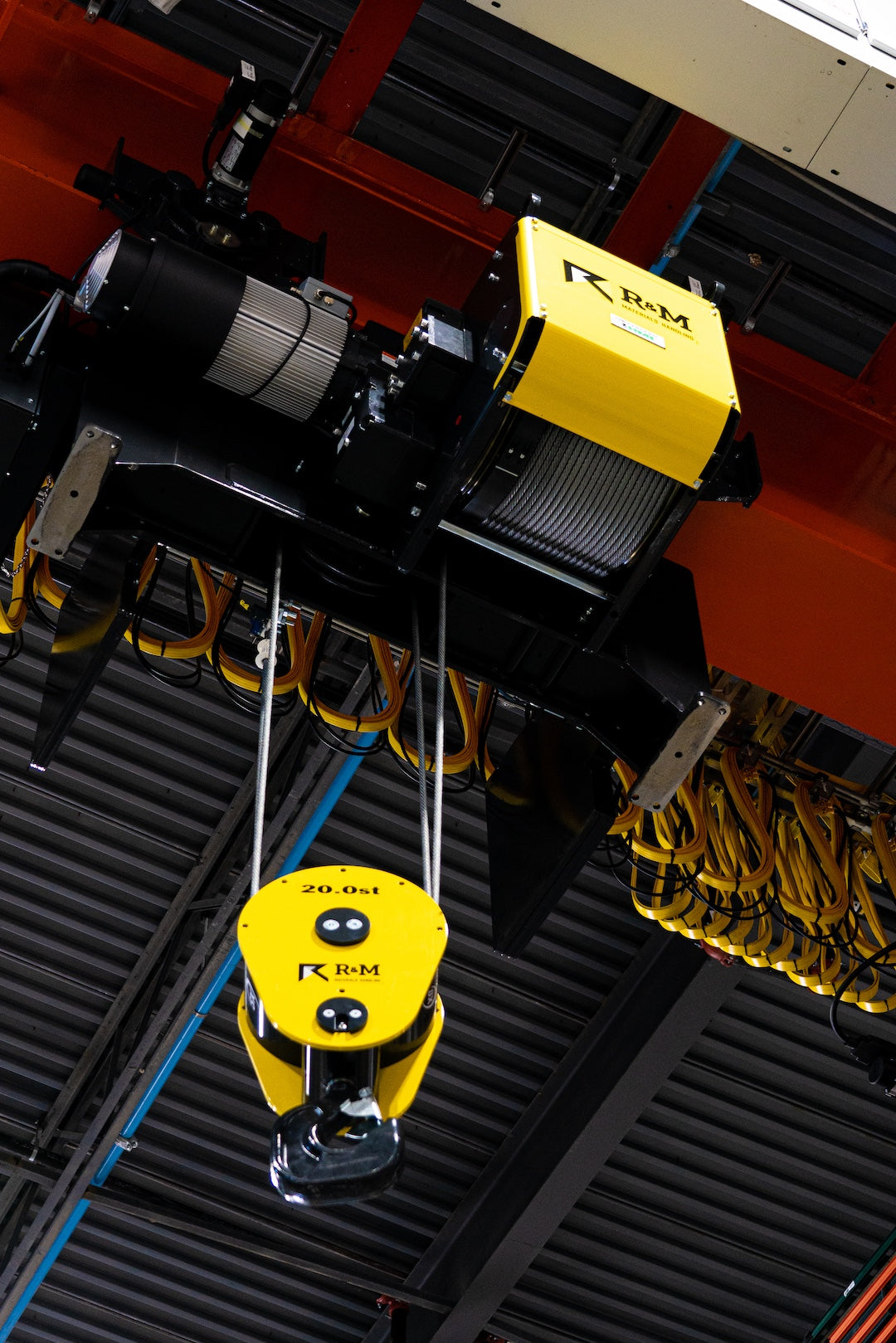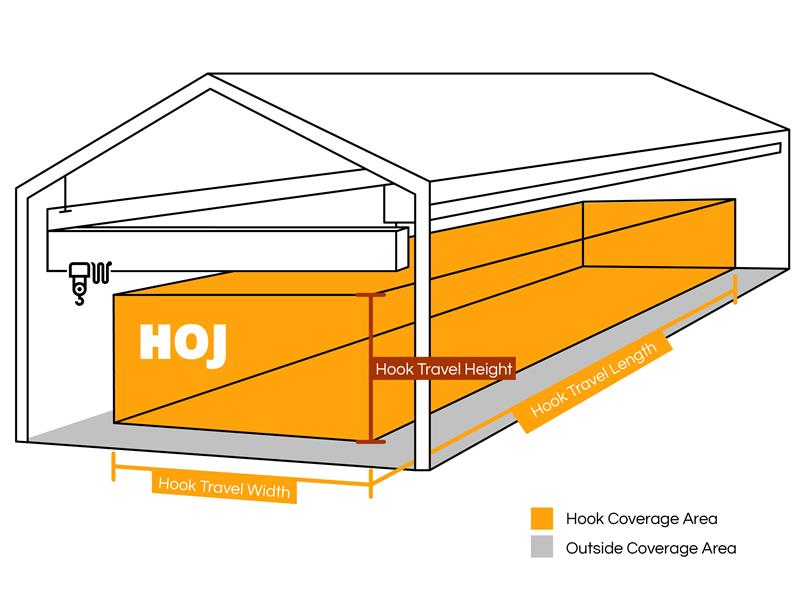Your Cart is Empty

Below the Hook Lifting Devices

Below the Hook (BTH) lifting devices are attachments that connect a load to an overhead crane or hoist so it can be lifted and moved safely. There are compatible BTH devices for all types of overhead cranes from single girders, double girders, jib, and gantry cranes and many more. A BTH device is "a device used for attaching a load to a hoist" and typically includes features like hooks, clamps, slings, or similar hardware to grab and secure the load.
These devices are critical for improving crane lift safety and efficiency, especially for handling heavy or awkward loads that are difficult to handle with standard slings.
An adequately designed BTH lifter allows better control of the load's balance and stability, reducing the risk of accidents and product damage. They also speed up operations by simplifying attachment and release, allowing more lifts in less time.
Device Overview
A typical BTH lifting device has several key components to support a load. Common components include:
-
Bail: The top connection point where the crane hook attaches. It can be a plate or pin style and must securely fit the crane's hook.
-
Lifting Lugs: These are secure connecting points on the lifter where slings or shackles can securely attach to.
-
Gussets: Reinforcement plates welded at high-stress areas to strengthen the lifter's structure.
-
Latch/Clamp: A locking mechanism that holds the lifter closed or open as needed.
BTH Working Principles
BTH lifters either mechanically hold the load or use power to attach. Mechanical types (like tongs, clamps, or spreader beams) rely on geometry and gravity – e.g. a scissor clamp grips tighter as the load is lifted.
Other lifters usevacuum suction or a lifting magnet to grab the load: vacuum lifters use suction pads and a vacuum pump for non-porous materials, while magnetic lifters use powerful magnets to lift ferrous metal objects. In all cases, the device is engineered to keep the load securely attached and well-balanced throughout the lift.
Typical Applications
BTH devices are used in many industries for tasks such as liftingsteel beams or pipes with spreader beams,hoisting steel coils with C-hooks,moving large panels or plates with vacuum lifters, andhandling machinery or fabricated parts with custom lifters.
They appear in manufacturing, warehousing, construction, steel mills – anywhere a crane must handle a load more safely or efficiently than can be done with just chains or lifting slings.

Types of Devices
Below the Hook lifting devices come in many forms to suit different loads. Key categories include:
Lifting Beams and Spreader Beams
Rigid beams that provide multiple pick points for better load balance. Alifting beam hangs from a single top bail and has two or more hooks underneath, useful when headroom is limited.
Aspreader beam uses top slings at each end to spread lifting points apart; it is lighter but requires more headroom.
Coil Hooks/Grabs
Devices for lifting heavy coils of steel, paper, etc. AC-hook is a C-shaped lifter that slips through the eye of a horizontal coil to lift it vertically. Motorized coil grabs can clamp onto a coil's OD and even rotate it between horizontal and vertical positions.
Gripping Lifters (Tongs/Clamps)
Lifters that grab the load by applying pressure. Examples include plate clamps for steel sheets or pinching tongs for pipes. These use friction or indentation force (scissor or cam action) to securely grip the load.
Magnetic Lifters
Lifting devices that use magnets to pick up ferrous metal loads. They can be permanent magnet types (with a manual lever) or electromagnets. Magnet lifters enable quick attachment and release of steel plates, bars, or scrap metals without slings.
Vacuum Lifters
Devices with suction pads that lift items by creating a vacuum seal. Commonly used for glass panes, sheet metal, or concrete panels, they allow non-destructive handling of large, flat objects.
Custom Lifters
Many Below the Hook devices are custom-engineered for specific tasks. For unique loads or special handling (e.g. flipping large machinery or lifting an assembly fixture), manufacturers will design tailor-made lifters to meet those exact needs.

Engineering and Customization
Designing a BTH lifting device starts with understanding theload requirements.
Engineers assess the load's weight, center of gravity, dimensions, and any special needs (fragile surface, high heat, etc.). They also considerfacility constraints like available headroom, clearance, and the crane's hook and capacity limits.
Using this information, the lifter is engineered (often per ASME BTH-1 design standards) with the appropriate safety factors and materials.
Creating a custom lifter typically involves collaboration between the user and manufacturer. The customer shares details of the lifting problem, and the manufacturer's engineers propose a solution.
For example, if a load needs to be rotated during lifting, the design might include a rotating mechanism.
Crane compatibility is ensured by designing the lifter's top interface to fit the crane's hook and by keeping the lifter's weight within the crane's capacity.
After design, most custom lifters undergo a proof load test and review before being put into service. By working closely with lifting specialists, companies get devices that solve their specific lifting challenges safely and efficiently.
Compliance and Safety Standards
Below the Hook lifters must meet strict safety standards.ASME B30.20 covers the construction, marking, inspection, testing, and operation of BTH devices, andASME BTH-1 covers the design criteria for these lifters.
In practice, reputable manufacturers adhere to these standards to ensure uniform safety and performance. OSHA regulations also apply: OSHA expects that BTH devices are labeled with their rated capacity and used within those limits, and it often references the ASME standards for guidance.
Every lifting device should have a nameplate or marking with the manufacturer, a unique identification (serial number), the lifter's weight if heavy, and its rated load capacity. Users must not use any lifter if this information is missing or illegible.
Regular inspections are also required. Operators should visuallyinspect before each use for any damage or defect. Additionally,periodic inspections by a qualified person (at intervals based on use, e.g. quarterly or annually) must be done and documented.
If any deficiencies are found – like cracks, bent parts, or excessive wear – the device should be taken out of service until repaired. Finally, lifters are typicallyproof load tested (often at 125% of rated capacity) before initial use or after major repairs to certify their integrity.
Adhering to these standards and practices (proper labeling, inspection, and testing) ensures compliance with OSHA and, more importantly, keeps lifting operations safe.
Device Selection Guide
Choosing the right BTH lifting device requires evaluating the load, the lifting conditions, and the equipment:

Evaluate the Load
Determine weight, size, shape, and center of gravity of the load. Identify how it can best be lifted – for example, through an eye or via clamping the sides. The load characteristics will narrow down suitable device types that can be used as a BTH accessory with your crane (beam, clamp, hook, etc.).
Check Crane and Constraints
Consider your crane's capacity (it must cover the load plus the lifter weight) and hook dimensions. Account for headroom,hook coverage area or spatial restrictions in the lift area. The lifter must fit and function within these limits (e.g., use a low-profile beam if headroom is minimal).
Consider Environment and Usage
Note the environment (indoors, outdoors, high heat, corrosive chemicals, etc.) and select a lifter made of appropriate materials or coatings for those conditions. Also think about frequency of use – a device used constantly in production should be heavy-duty and perhaps have features that speed up repetitive lifting (like automatic latches or remote control).
Ensure Compliance and Get Advice
Only use devices that are properly rated and labeled (meeting ASME/OSHA requirements).
Avoid jury-rigged or homemade solutions. If unsure about what you need, consult with the lifting device manufacturer or a rigging specialist. They can recommend standard devices or design a custom lifter for your specific application, ensuring you get a safe and effective solution.
Selecting the right lifting device is critical for your facility's safety and efficiency. HOJ Innovations will help you find the best BTH lifter for your unique needs.
Don't settle for guesswork—choose precision and expertise. Contact HOJ Innovations today to find your ideal lifting solution.
Common Challenges
Even with the right equipment, improper use can lead to problems. Be mindful of these common challenges.
Wrong Device or Ignoring Conditions
Using an unsuitable lifter (or exceeding its capacity) is a frequent mistake. Examples include lifting a load heavier than the device's rating or not using a spreader when needed for a long load. Also, not accounting for conditions (like temperature or moisture) can cause issues – for instance, a clamp may slip on oily surfaces, or a normal lifter might fail in a hot furnace area if not designed for high heat. Always match the lifter type and capacity to the load and environment.

Inadequate Training
A well-designed device can still be misused if the operator isn't trained. Common errors include failing to center the load under the hook, not fully engaging a latch, or using a device incorrectly (like sideways loading a beam). "Employing inadequately trained riggers is one of the worst mistakes" in overhead lifting. Ensure operators know the proper use of each BTH device and safe rigging practices.
Poor Inspection and Maintenance
Skipping inspections or overlooking wear can lead to accidents. For example, continuing to use a lifter with a cracked weld or stretched hook can result in a sudden failure under load. It's essential to remove from service any lifter that shows significant wear, damage, or missing parts (like a broken latch spring or illegible tag) until it's repaired or replaced. Regular maintenance – cleaning, lubrication, and timely part replacements – will prevent many problems and is much cheaper than dealing with the aftermath of a dropped load.
Benefits and ROI
Investing in Below the Hook lifting devices yields significant benefits:
-
Enhanced Safety: Purpose-built lifters secure loads more reliably and reduce the chance of drops or mishaps. They also keep personnel safer (e.g. using a remote-release hook means a rigger doesn't need to be under or near the load).
-
Higher Efficiency: BTH devices often allow faster attachment and movement of loads. This efficiency means more lifts can be done in a given time and with fewer people, boosting productivity.
-
Cost Savings: Fewer accidents and less product damage directly save money. Additionally, proper lifters prevent undue stress on cranes (no side-loading or improvised rigging that could harm equipment), reducing repair costs and downtime. Over time these savings can outweigh the cost of the device.
-
Extended Equipment Life: By handling loads in a controlled manner, BTH devices lessen wear and tear on slings and crane components. Smooth, balanced lifts mean the crane and lifting gear are used within ideal parameters, often extending their service life.
Maintenance Best Practices
To keep Below the Hook devices safe and long-lasting, follow these practices:
Regular Inspections
Always do a quick check before each use and scheduled in-depth inspections. Look for cracks, bent or worn parts, malfunctioning latches, or other issues. If something is wrong, do not use the device until it's fixed.
Cleaning and Storage
Keep lifters clean and dry. Wipe off dirt, oil, or chemicals after use to prevent corrosion or degradation. Store devices in a protected area – preferably indoors, off the ground – to avoid rust or accidental damage. For example, hang smaller clamps on a rack and set larger beams on supports undercover.
Lubrication and Repair
Lubricate moving parts (hinges, pins, etc.) as recommended to ensure smooth operation and reduce wear. Replace any worn-out or damaged components promptly – such as pins, springs, or pads – rather than waiting for them to fail. If a critical part is cracked or the device is significantly deformed, have the manufacturer or a qualified engineer evaluate and repair it.
Never use a jerry-rigged fix or operate a lifter with a known defect.
By diligently maintaining BTH devices, you ensure they perform as designed and avoid unexpected failures. Good maintenance not only improves safety but also maximizes the equipment's lifespan and reliability.
Future Trends
Below the Hook lifting devices are evolving with technology:
-
Smart Sensors and IoT: New lifters are beingequipped with sensors (like load cells) that provide real-time data on load weight and balance. This data can be sent to operators or integrated into facility IoT systems for monitoring. Smart lifters might, for example, warn if a load is off-center or approaching capacity.
-
Automation and Remote Operation: We are seeing moreremote-controlled hooks and lifters, allowing operators to latch or release a load from a safe distance. Some systems use automation or AI for precise positioning and handling of loads. These advancements improve safety and can speed up repetitive lifting tasks.
-
Advanced Materials: Manufacturers are exploring lightweight, high-strength materials for building lifters. Examples include composite (fiber-reinforced) spreader beams and use of high-strength alloys. Such materials reduce the lifter's weight (increasing net lifting capacity) and often are more resistant to corrosion or fatigue, contributing to sustainability and efficiency.
Conclusion and Recommendations
Below the Hook lifting devices, when properly applied, greatly improve lifting safety and efficiency. To get the most from these tools, alwaysselect the right lifter for the job (correct type and capacity),follow all safety guidelines (ensure devices are certified, inspected, and used by trained staff), andkeep the equipment well-maintained.
It's wise to involve professionals—like those at HOJ Innovations—to recommend compliant, manufacturer-built lifting devices that match your exact needs.
By prioritizing the proper use and care of BTH lifting devices, you protect your workers, your load, and your lifting equipment. In turn, your operations become safer and more productive.
Remember that every lift should be assessed. If you have any doubts about the equipment or method, stop and consult a qualified professional. With the right device and approach, Below the Hook lifters will provide a strong return on investment through safer lifts, fewer accidents, and smoother workflow.








